Grandma's pickles stay fresh longer because she follows time-tested preservation methods. You'll need the right salt-to-water ratio (3-4.5% brine), fresh pickling cucumbers harvested at their peak, and properly sterilized jars. The magic happens when beneficial bacteria convert natural sugars into lactic acid, creating that perfect tangy flavor while preventing spoilage. Keep your pickles submerged in brine, stored at 32-40°F in the refrigerator after opening, and use clean utensils each time you grab one. Proper fermentation and storage techniques can extend your pickles' shelf life up to two years – and there's much more to this preservation puzzle.
The Magic of Salt Brine
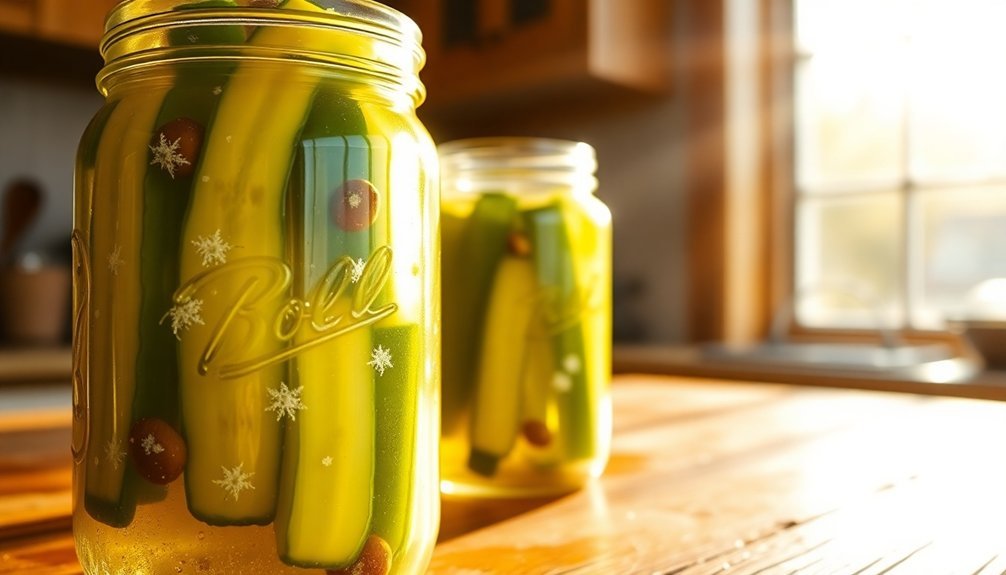
Down in every jar of perfectly fermented pickles lies the carefully balanced chemistry of salt brine. When you're making pickles like Grandma did, you'll need to maintain a precise salt-to-water ratio – typically 3% for shorter fermentations or 4.5% for longer storage. This means you'll add about 2 tablespoons of fine sea salt or Himalayan salt per quart of water.
Your water choice matters just as much as your salt. You'll want to use filtered, spring, or well water to avoid chlorine, which can inhibit fermentation. If you're using tap water, let it sit overnight or boil it first to remove the chlorine. Gently heating the water first helps the salt dissolve completely for a more effective brine.
The salt brine isn't just flavoring – it's your pickle's protection system. It creates an environment where good bacteria thrive while harmful ones can't survive.
You'll notice the brine creating an anaerobic environment that promotes lactic acid bacteria growth, which gives your pickles their characteristic tang. The salt also helps keep your cucumbers crisp by preventing the enzymes that cause softening from taking over.
To achieve consistent results, you'll need to measure your salt precisely every time.
Time-Tested Traditional Fermentation Methods
You'll find that creating crisp, flavorful pickles starts with the perfect ratio of salt to water in your brine, which needs to be fully dissolved before adding to your cucumbers.
When choosing your fermentation vessel, opt for traditional glass jars or ceramic crocks that won't react with the brine and can maintain consistent temperatures. This age-old process promotes the growth of beneficial bacteria that creates complex flavors while naturally preserving your vegetables.
To guarantee proper fermentation, you'll want to store your jars in a dark spot where temperatures stay between 70-75°F, checking them periodically to remove any surface scum.
Salt Brine Magic Works
The secret to perfectly fermented pickles lies in mastering the salt brine, a time-tested method that's been passed down through generations.
You'll want to start with a 3% salt solution, which means adding 7 grams (one heaping teaspoon) of fine sea salt per cup of water. Using high-quality sea salt or Himalayan salt isn't just about taste – it's essential because these salts are non-iodized and packed with minerals that support healthy bacterial growth. For food safety, regular brine refreshing helps maintain proper acidity levels throughout the fermentation process.
Your brine strength directly affects fermentation time and pickle characteristics. Here's what you need to know:
- A 3% brine creates half-sour pickles in 3-5 days, perfect for those who prefer a milder taste.
- A 3.5% brine offers a middle ground, with 9 grams of salt per cup of water.
- A 4.5% brine produces full-sour pickles in 14-21 days, yielding that classic tangy crunch.
You'll need to keep your cucumbers completely submerged using fermentation weights or a water-filled zip lock bag.
Remember to maintain temperatures between 64-72°F for ideal fermentation. Once your pickles reach your desired sourness, store them in the refrigerator, where they'll keep for 4-6 months.
Old-School Jar Selection
Right up on the shelf, those traditional glass jars from grandma's day remain the gold standard for pickle fermentation. You'll want to select thick, durable glass jars that are free from any cracks or imperfections, just as generations before you did.
Wide-mouth quart or half-gallon jars are your best bet, offering easy access for both packing and retrieving your pickles.
When you're choosing your jars, remember that air-tight sealing is non-negotiable. While you'll start with a loose lid during the initial fermentation to let gases escape, you'll need to switch to an air-tight lid for long-term storage. This prevents unwanted bacteria from sneaking in and protects your pickle's flavors and textures.
Don't underestimate the importance of proper sizing. You'll want your jar to comfortably fit your vegetables while leaving enough headspace for brine.
If you're following grandma's traditional methods, consider using fermentation weights or clean stones to keep your vegetables submerged. Modern alternatives like specialized fermentation lids with airlocks can also help maintain that perfect environment your pickles need to thrive.
Dark Storage Secrets
Mastering the art of dark storage plays an essential role in achieving perfectly fermented pickles. You'll want to find a warm spot away from direct sunlight and appliances, where temperatures stay between 65-75°F for ideal fermentation. This sweet spot guarantees your pickles develop that authentic tangy flavor without becoming too soft or spoiling.
During the initial fermentation period, which typically lasts 3-4 weeks in ideal conditions, you'll need to monitor your pickles regularly. After this phase, transfer them to a cooler environment between 32-50°F for long-term storage, where they can continue developing complex flavors for up to six months.
- Check your fermentation area daily, removing any surface scum or mold that might develop.
- Store finished pickles in the refrigerator to markedly slow the fermentation process.
- Trust your senses – if pickles become slimy, soft, or develop an off-putting odor, it's time to discard them.
Remember that temperature control is your greatest ally in pickle fermentation. While warmer temperatures speed up the process, cooler storage helps preserve your pickles' crunch and extends their shelf life considerably.
Selecting Perfect Pickling Cucumbers
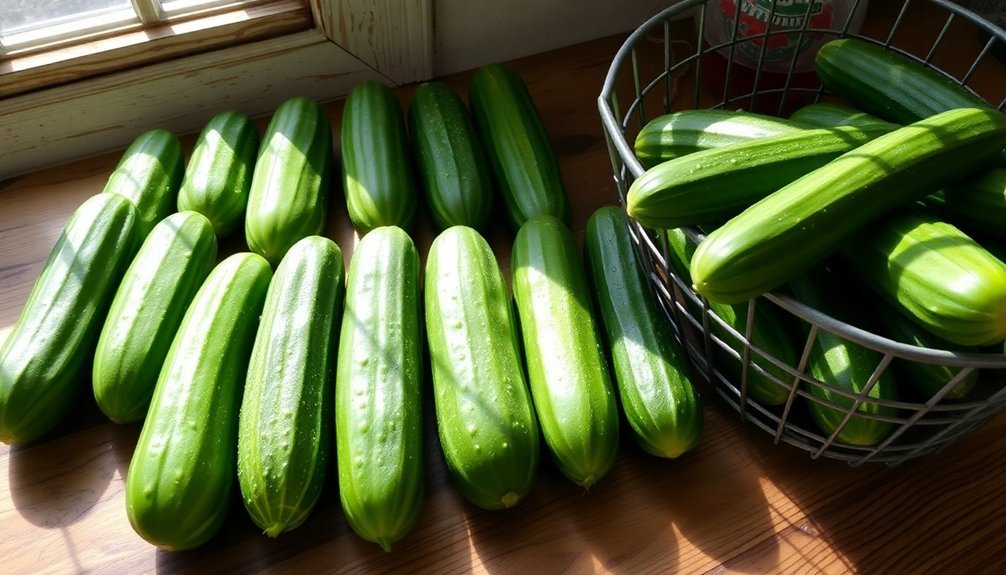
When selecting cucumbers for your pickling project, you'll want firm specimens measuring about 4 inches for dills or 1½ inches for gherkins, with no soft spots or yellowing.
You're better off picking your cucumbers early in the day while they're fresh and crisp, rather than buying waxed ones from the store.
Make sure you choose cucumbers of similar size for even pickling, and always pick them before they become overripe or bitter.
Size and Firmness Matters
Selecting the perfect pickling cucumber starts with understanding ideal sizes for different pickle styles. For crispy gherkins, you'll want to harvest them when they're just 1½ inches long. If you're making dill pickles, aim for cucumbers that are 4 inches in length. The key is to pick them at their peak firmness, when they're dark green and free from any blemishes.
The texture of your pickling cucumbers is just as vital as their size. You'll want varieties specifically bred for pickling, as they've thicker skins and less water content in their flesh. These characteristics guarantee you'll get that satisfying crunch in your final product. Remember to avoid waxed cucumbers, as they won't properly absorb the pickling solution.
- For gherkins: harvest at 1½-2 inches
- For dill pickles: aim for 4-5 inches
- For relishes and bread-and-butter: can use slightly larger, up to 6 inches
Look for cucumbers with a uniform, cylindrical shape and slight tapering at the ends – this makes them perfect for packing into jars. The skin should be thin enough that you won't need to peel it unless it's waxed.
Harvest Time Tips
The art of timing your cucumber harvest directly impacts the success of your pickling endeavors. For perfect pickling cucumbers, you'll want to harvest them when they reach 2 to 4 inches in length. If you're making traditional dill pickles, aim for cucumbers that are 3 to 4 inches long, while gherkins should be picked at 1½ to 2 inches.
You'll need to monitor your cucumber plants daily or every other day since they grow surprisingly fast. Once you spot the first female flowers, you can expect ripe cucumbers within 8 to 10 days. Don't wait too long to harvest, as oversized cucumbers won't pickle well.
When you're ready to pick, use sharp garden shears or a knife to cut the cucumbers, leaving about an inch of stem attached. Don't twist or pull them off the vine, as this can damage both the plant and fruit. If you're handling prickly varieties, wear gloves to protect your hands.
Select firm, bright green cucumbers without blemishes, and compost any that are misshapen or show signs of damage. Regular harvesting encourages continued production, so stay vigilant throughout the growing season.
Fresh Vs Store Bought
Making an informed choice between fresh and store-bought cucumbers can considerably impact your pickle-making success. When you opt for fresh cucumbers, you'll get superior taste, better nutritional value, and the ability to customize your pickles exactly how you want them.
Fresh ingredients allow you to control the entire pickling process, from selecting chemical-free vegetables to adjusting spice levels and salt content.
Store-bought options might seem convenient, but they often come with significant drawbacks. You'll find they're loaded with artificial preservatives, have diminished nutritional value, and lack the probiotic benefits that make homemade pickles so healthy.
While they offer longer shelf life, it's at the cost of authentic flavor and natural goodness.
Here's why you should choose fresh cucumbers for pickling:
- You'll get maximum probiotic benefits through natural fermentation, supporting your gut health and immunity.
- You can customize spice levels, salt content, and cutting styles to match your preferences.
- Fresh ingredients guarantee you're avoiding artificial preservatives, colors, and flavor enhancers that are common in commercial products.
When it comes to achieving Grandma's pickle perfection, fresh ingredients are your key to success.
Essential Tools and Equipment
Proper pickle-making equipment can make or break your preserving success. You'll need high-quality preserving jars in various sizes, with both wide-mouth and regular options available. Don't forget new lids for each batch – they're vital for proper sealing and food safety. While rings can be reused, lids must be fresh each time.
| Essential Tools | Their Purpose |
|---|---|
| Jar Lifter | Safely remove hot jars from water |
| Preserving Funnel | Pour brine without spills |
| Debubbler | Remove trapped air bubbles |
| Kitchen Scale | Guarantee accurate measurements |
For the actual pickling process, you'll want a large stock pot or water bath canner with a metal rack to keep jars stable. A sharp knife for consistent vegetable cuts and proper measuring tools will guarantee your recipes turn out right every time. If you're planning to ferment, invest in air locks and weights to keep vegetables submerged. Don't forget sanitizing supplies – clean equipment is vital for safe preservation. Finally, keep a notebook handy to record your successes and tweaks to recipes. With these tools at your disposal, you're ready to create pickles that'll rival Grandma's best batches.
Perfect Storage Environment

In accordance with expert preserving practices, creating the perfect storage environment for your pickles guarantees they'll maintain quality and safety for months to come.
Before opening, store your jars in a cool, dry pantry away from heat sources and direct sunlight. Once opened, transfer them to your refrigerator's middle shelf, maintaining temperatures between 32°F and 40°F.
You'll want to use nonreactive containers with tight-fitting lids, making sure your pickles stay completely submerged in their brine. Keep them filled to the brim to minimize air exposure, and always use clean utensils when retrieving pickles to prevent contamination.
- Temperature Control
- Store unopened jars at 50-60°F
- Keep opened jars at 32-40°F
- Avoid temperature fluctuations
- Container Requirements
- Use glass, stainless steel, or food-grade plastic
- Make certain tight-fitting lids
- Keep pickles submerged in brine
- Maintenance Steps
- Clean utensils before each use
- Remove jar rings after processing
- Check seals regularly
- Store in original brine solution
Your storage area should be well-ventilated to prevent moisture buildup, and it's best to dedicate a specific shelf solely to your pickles to avoid cross-contamination.
Monitoring the Fermentation Process
While proper storage keeps your pickles safe long-term, successful fermentation creates those signature flavors you're after. You'll need to monitor several key factors to guarantee your fermentation process stays on track.
Start by using Lactobacillus plantarum as your starter culture – it's highly salt-tolerant and excellent at producing the acids needed for preservation. You'll want to watch the chemical changes closely, particularly the pH levels and acid production. These changes aren't just about flavor; they're vital for preventing harmful bacteria like Clostridium botulinum from growing.
You can track your fermentation progress using modern tools like colorimetric sensor arrays, which detect the volatile compounds produced during fermentation. If you don't have access to high-tech equipment, you'll need to monitor the basics: salt concentration, acidity levels, and signs of unwanted growth like mold or kahm yeast.
Keep checking your pickles' sourness regularly. When they reach your desired taste, move them to the fridge.
Remember to use pure canning salt without additives, as iodine or anti-caking agents can interfere with the fermentation process and affect your final product's quality.
Signs of Successful Preservation
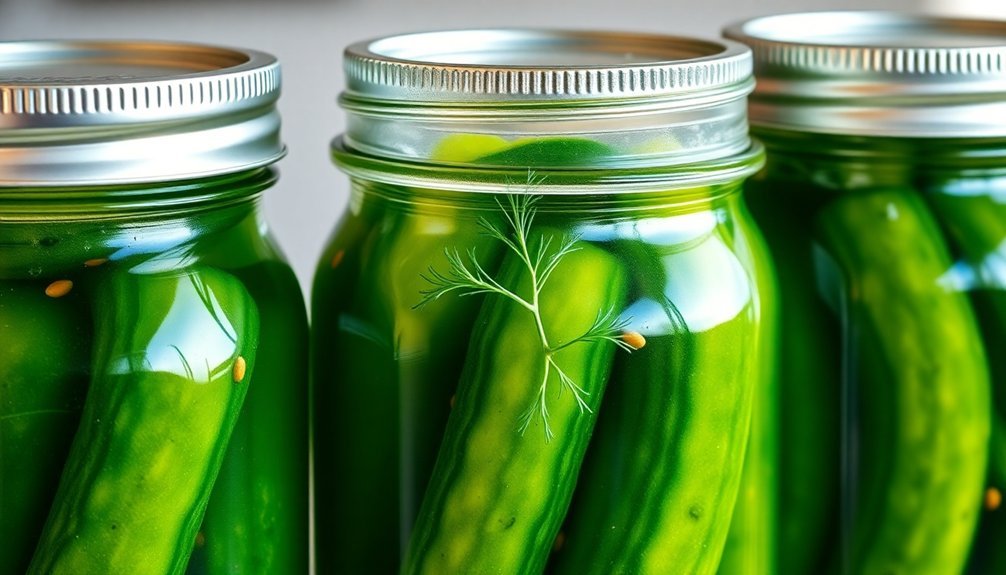
You'll know your pickles are properly preserved when they maintain their bright color and crisp texture while remaining fully submerged in clear brine.
The development of beneficial lactic acid bacteria creates a tangy flavor and naturally protects against harmful microorganisms through fermentation.
Watch for any signs of spoilage like softening, discoloration, or cloudy brine, which indicate the preservation process hasn't succeeded.
Color and Texture Changes
Successfully preserved pickles undergo distinct color and texture transformations that signal proper fermentation. You'll notice your cucumbers changing from bright green to an olive or yellow-green shade during the brining process. When done correctly, the interior becomes uniformly translucent, indicating proper curing.
To maintain peak quality, you'll need to watch out for several factors that can affect your pickles' appearance and texture. Hard water minerals, inappropriate utensils, and improper storage conditions can all lead to unwanted changes.
Store your preserved pickles in a cool, dark, and dry place to prevent texture breakdown and color alterations.
- Color indicators of proper preservation:
- Uniform olive or yellow-green shade
- Translucent interior
- No spotting or dullness
- Storage requirements for maintaining quality:
- Cool, dark location
- Dry environment
- Refrigeration after opening
- Common preservation mistakes to avoid:
- Using iodized salt instead of pickling salt
- Leaving whole spices in jars
- Using brass, copper, or zinc utensils
Remember that while some color changes are normal, others might indicate preservation problems that could affect your pickles' safety and quality.
Proper Brine Coverage
Keeping pickles submerged beneath the brine is essential for successful preservation. The brine solution acts as your primary defense against spoilage, creating an acidic environment that inhibits bacterial growth while maintaining your pickles' signature crunch. You'll want to guarantee your cucumbers stay completely covered by using weights or other methods to keep them below the surface.
You can easily monitor your pickles' preservation success by watching for key indicators. When you've achieved proper coverage, you won't see any surface mold, scum, or murky liquid. Your brine should remain clear or slightly cloudy, and the pickles should stay firm and crisp.
Store your containers in a cool, dark place, avoiding direct sunlight that could compromise quality. To maintain proper preservation, you'll need to inspect your pickles regularly. Use clean, dry utensils when handling them, and store them in nonreactive containers like glass, stainless steel, or food-grade plastic.
If you notice any off-odors, sliminess, or surface mold, address these issues immediately. Keep the storage temperature between 40°F and 75°F for ideal results, and you'll enjoy perfectly preserved pickles for months to come.
Beneficial Bacteria Development
Once your pickles are properly submerged in brine, a fascinating biological process begins. Beneficial bacteria start consuming the natural sugars in your vegetables, producing lactic acid and carbon dioxide. This fermentation process creates an acidic environment that's essential for preservation, with the pH dropping below 4.6 to prevent harmful bacteria like Clostridium botulinum from growing.
You'll know your fermentation is successful when you observe these key indicators:
- Clear brine with firm, crisp pickles that maintain their texture
- Development of characteristic tangy flavors without any off-odors
- Absence of mold, unusual colors, or suspicious changes in appearance
Your properly fermented pickles will need refrigeration for long-term storage, typically lasting 2-4 months when homemade. If you're working with commercial varieties, they can last 1-2 years past their best-by date when stored correctly in a cool, dark place.
The lactic acid bacteria don't just preserve your pickles – they also create beneficial probiotics that support gut health, making your grandmother's pickle recipe not just delicious but nutritious too.
Common Preservation Mistakes
Making perfect pickles requires careful attention to detail, and even experienced canners can fall prey to common preservation mistakes. When your brine isn't strong enough or properly balanced, you'll end up with soft, slippery pickles that won't satisfy anyone's craving for that signature crunch. You'll need to use 5% acidity vinegar and maintain the correct salt concentration to avoid this issue.
| Issue | Solution |
|---|---|
| Soft Pickles | Don't exceed 15-minute processing time for quarts |
| Poor Sealing | Use new lids and clean jar rims thoroughly |
| Mushy Texture | Select fresh, firm cucumbers and remove blossom ends |
| Contamination | Keep equipment sanitized and remove surface scum |
Watch out for processing mishaps too – over-boiling your pickles or improper jar sterilization can ruin your batch. You'll want to use fresh ingredients, as moldy garlic or stale spices can compromise both safety and flavor. Don't forget to remove those blossom ends – at least 1/16 inch needs to go to prevent enzyme-related softening. Keep your cucumbers fully submerged in brine and store your finished jars in a cool, dark place to maintain quality.
Maintaining Proper Temperature Control
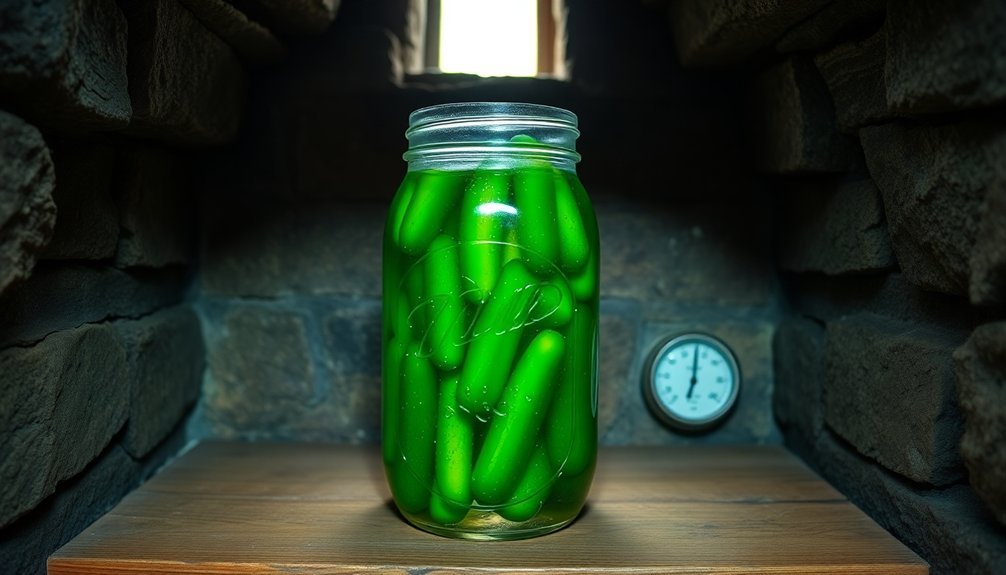
Temperature control stands at the heart of successful pickle fermentation, with even small fluctuations affecting your final product's quality.
You'll want to maintain temperatures between 70ºF and 75ºF for peak fermentation, though you can still achieve good results at cooler temperatures of 55º to 65ºF – just expect a longer process of 5 to 6 weeks.
Never let your fermentation temperature exceed 80ºF, as this will result in mushy pickles.
For heat processing, you'll need to choose between two methods: the traditional boiling water bath at 212ºF or low-temperature pasteurization at 180º to 185ºF for 30 minutes.
The latter helps preserve crispness but requires careful monitoring with a food thermometer.
Here's what you need to monitor for perfect temperature control:
- Check fermentation temperature daily, keeping it consistent for even results
- Monitor water temperature during processing, adjusting for altitude if necessary
- Maintain proper storage temperatures after processing – refrigerate opened jars and keep unopened ones in a cool, dark place
Remember to regularly remove any surface scum during fermentation and storage to guarantee your pickles stay fresh for months to come.
Jar Selection and Preparation
Proper jar selection and preparation serve as the foundation for successful pickle making. You'll want to choose between ceramic, glass, or plastic jars, with glass being the ideal choice for its non-porous nature and ability to maintain flavor without absorbing odors.
Glass jars won't alter the taste of your pickles and will keep them fresh longer than plastic alternatives.
Select your jar size based on your specific needs. If you're making pickles for a large family, opt for bigger jars, while smaller containers work better for individual portions. Remember to leave enough headspace at the top for proper sealing and guarantee the jar can accommodate both your pickles and brine comfortably.
Before you begin, thoroughly wash your jars with hot soapy water and dry them completely. You'll need to sterilize them to prevent contamination, and it's best to keep them warm when filling with hot pickling syrup.
Place your clean jars on a kitchen towel during preparation. Don't forget to choose airtight lids that can withstand high temperatures and check for proper sealing to prevent spoilage. A secure seal is essential for maintaining freshness and extending shelf life.
Seasonal Pickle Making Tips
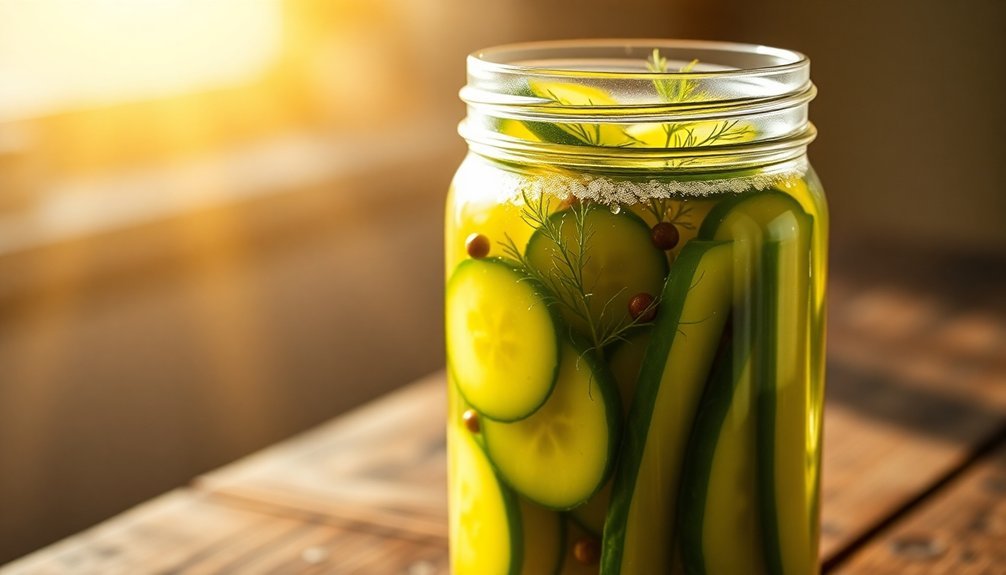
Nature's seasonal bounty provides the perfect opportunity for making delicious, crisp pickles. You'll want to select the freshest, most uniform vegetables at their peak ripeness, avoiding waxed supermarket produce that might compromise your pickle quality.
When handling cucumbers specifically, don't wash them before storage; instead, wipe them clean with a rag and store them in a tightly tied plastic grocery sack to maintain freshness.
To guarantee your pickles turn out perfectly crisp and flavorful, follow these essential steps:
- Cut off a ¼-inch slice from the blossom end of cucumbers and discard it to prevent softening during the pickling process.
- Cut all vegetables into uniform pieces (whether you're choosing sticks, slices, or cubes) to guarantee even pickling throughout.
- Layer your prepared vegetables with pickling salt overnight to enhance their crispness before the actual pickling begins.
For best results, you'll need to wait at least three weeks before sampling your pickles. This waiting period allows the flavors to mellow and develop fully.
Remember to select tender beans and separate florets when working with vegetables like cauliflower and broccoli for the best texture in your finished pickles.
Long-Term Storage Solutions
Storing pickles for the long haul comes down to mastering a few key preservation methods. You'll want to choose between traditional fermentation, modern canning, or quick refrigeration techniques based on your storage goals and available space.
For fermented pickles, you'll need to keep them submerged in brine using nonreactive containers and weights. Once the fermentation process is complete, store them in the refrigerator to maintain their crisp texture and signature tangy flavor for up to three months.
| Storage Method | Container Type | Temperature | Shelf Life |
|---|---|---|---|
| Fermentation | Glass/Ceramic | 35-40°F | 3-6 months |
| Canning | Glass Jars | Cool, dark | 1-2 years |
| Quick Pickling | Glass/Plastic | 35-40°F | 2-3 months |
| Vacuum Packed | Sealed Bags | Room temp | 6-12 months |
If you're planning for extended storage, consider water bath canning with vinegar-based brines in properly sealed jars. These can last up to two years when stored in a cool, dark place. For modern convenience, vacuum-packed pickles offer extended shelf life without sacrificing quality, though you'll need specialized equipment for this method.
Safe Handling Guidelines
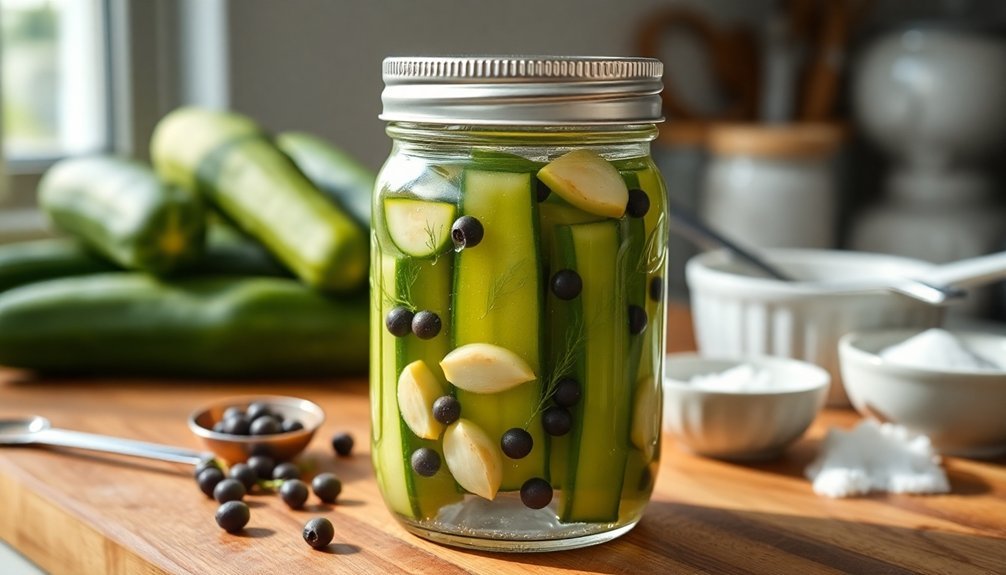
Four essential principles guide the safe handling of pickles: clean ingredients, sterile equipment, proper processing, and vigilant monitoring.
When you're selecting produce, choose only fresh, firm vegetables without blemishes or signs of decay. Don't forget to trim that tiny 1/16-inch slice from cucumber ends to maintain crispness.
Your equipment needs to be impeccably clean. Sterilize jars in boiling water for 10 minutes and simmer lids at 180°F. You'll want to use pure, noniodized pickling salt and guarantee all your utensils are sanitized before starting.
- Before processing:
- Check jar rims for chips
- Remove air bubbles from packed jars
- Adjust headspace according to recipe
- During processing:
- Use boiling water bath for proper time
- Adjust processing time for altitude
- Heat brine to boiling before pouring
- After processing:
- Verify proper seal formation
- Check for signs of leakage
- Store in cool, dark place
- Monitor for unusual colors or odors
Frequently Asked Questions
Can Fermented Pickles Help With Digestive Health and Gut Bacteria?
Yes, you'll benefit from fermented pickles as they're packed with probiotics that improve your digestive health. They'll boost your gut bacteria, help with nutrient absorption, and can reduce stomach issues naturally.
Why Do Some Pickles Float Even With Proper Weights in Place?
Your pickles may float due to air trapped inside the cucumber's flesh, especially if they're older or less fresh. Even with weights, internal air pockets and lower density can overcome the downward pressure.
Is It Safe to Give Homemade Fermented Pickles to Pregnant Women?
You shouldn't give homemade fermented pickles to pregnant women. They're 10 times more susceptible to Listeria infections, which can cause serious complications. Stick to store-bought pickles that follow strict safety standards instead.
Can You Reuse the Brine From a Previous Batch of Pickles?
You can't reuse brine for canning pickles as it's unsafe, but you can use it for refrigerator pickles. Just reboil the brine, add fresh vinegar, and store your new batch in the fridge.
Do Different Cucumber Varieties Produce Noticeably Different Flavors When Fermented?
Yes, you'll notice distinct differences. Kirby cucumbers give you intense flavors, while Persian ones offer balanced, slightly sweet notes. Pickling cucumbers maintain better crunch, and English varieties provide milder results.
In Summary
You'll find that grandma's pickles stay fresh because she follows time-honored preservation methods. By using the right salt concentration, proper fermentation techniques, and ideal storage conditions, you're creating an environment where harmful bacteria can't survive. When you combine these elements with carefully selected cucumbers and sterile jars, you'll enjoy crisp, flavorful pickles that last for months. Remember, patience and attention to detail are your best preservation tools.

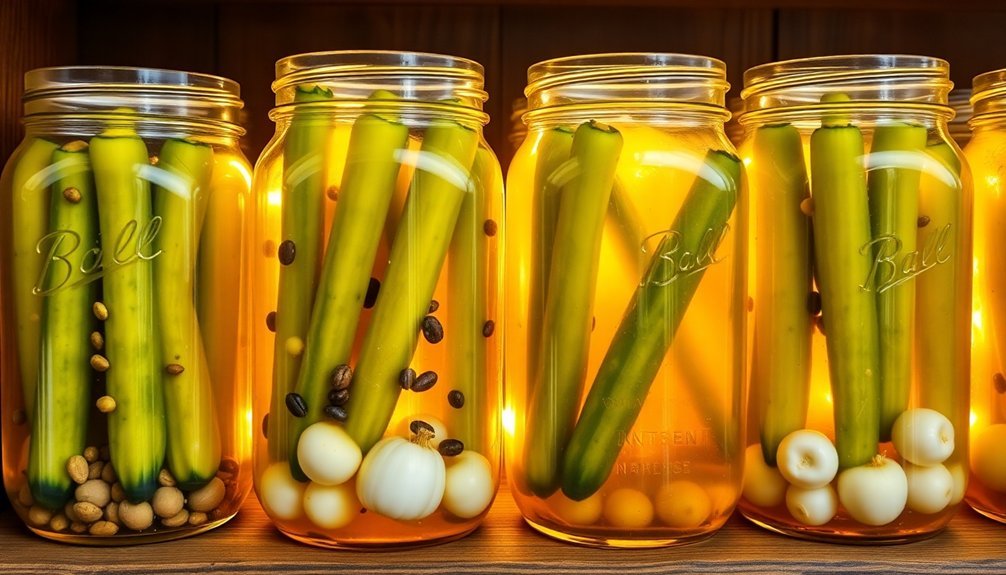



Leave a Reply